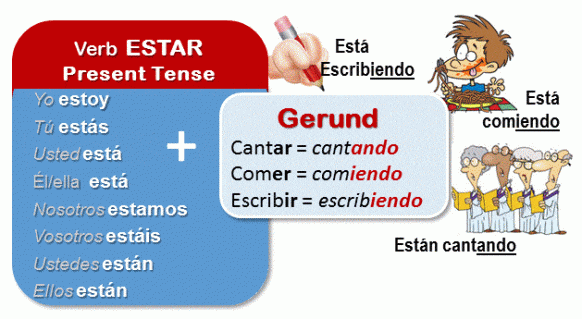Present progressive in Spanish -also called present continuous- is used to talk about something that is happening at this very moment, as when in English you say: I am eating, he is talking, we are working…
In this post, we are going to learn how and when to use the present progressive in Spanish, how to conjugate it, and something else that will be very useful to you. You also have many examples, a video and quizzes to practice.
Spanish Present progressive conjugation

1. As you have seen above, it is formed from the present tense of ESTAR and the GERUND of the main verb:
Estoy comiendo paella (I am eating paella).
Estamos trabajando en proyecto nuevo (we are working on a new project).
¿Quién está llamando a la puerta? (Who is knocking the door?).
2. Just at a glance, to form the gerund we will take the ending of the infinitive and we will add –ando (for those ending in -ar) or –iendo (for other two groups) and is the same as the –ing form of the verb in English:
- Escuchar (listen) – .. = escuchando (listening).
- Comprender (understand) – ..= comprendiendo (understanding).
- Recibir (to receive) – .. = recibiendo (receiving).
Although there is a small group of verbs that made their gerund in an irregular way: leer ( to read): leyendo; decir (to say): diciendo; construir (to build): construyendo; poder (to can): pudiendo; dormir (to sleep): durmiendo.… Learn more about el gerundio (gerund).
What is the present progressive in Spanish
Notice that in Spanish we only use the present continuous to talk about a thing that is in the middle of happening right now or to present a situation as temporal, NEVER to express future like in English:
Llévate el paraguas, está lloviendo mucho (Take the umbrella, it is raining a lot).
Este invierno está lloviendo mucho (This winter is raining a lot).
Nos marchamos mañana (we are leaving tomorrow).
Present continuous in Spanish quiz
Now it is time to practice everything you have learned with the quizzes below. Remember to contact your tutor with any questions you have about how to use ESTAR + GERUND. Don’t you have an online Spanish tutor yet?
Now that you know how to use the present progressive in Spanish, it is important not to mistake it with the present simple, which is used more for routines and unquestionable facts.
Vivo en España (I live in Spain).
Estoy viajando por España (I am traveling through Spain).
Los elefantes son unos animales enormes (Elephants are huge animals).
Los elefantes están siendo cazados en muchos lugares (Elephants are being hunted in many places).
You can learn more about these differences in the video below.
What is the present continuous in Spanish
The Spanish present continuous is a verbal periphrasis. They are constructions that consist of two or more verbs that work as one. I am sure you have already seen some of them:
Voy a aprender español (I am going to learn Spanish).
Tengo que estudiar vocabulario (I have to study vocabulary).
Quiero hablar bien español (I want to speak Spanish well).
Llevo tres meses estudiando español (I have been studying Spanish for 3 months).
They are terribly useful so I advise you to study them in the link above
Acabo de ... "I have just done something"
If you want to say, not that you are doing something, but that you have just done something in Spanish, you need to use the periphrasis «acabar de + infinitive». Click on the link to learn more about this topic, it is very easy to use and will be terrible useful.